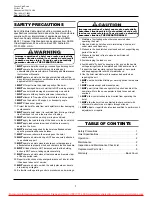
1
Country Club Road
P.O. Box 779
Wadesboro, NC 28170 USA
TEL: (800) 477-5003
FAX: (800) 374-6853
SAFETY PRECAUTIONS
Each Little Mule Cable Hoist is built in accordance with the
specifications contained herein and at the time of manufacture
complies with our interpretation of applicable sections of
American Society of Mechanical Engineers Code (ASME)
B30.21. Copies of this Standard can be obtained from ASME
Order Department, 22 Law Drive, Box 2300, Fairfield, NJ
07007-2300, U.S.A.
1.
NOT
operate a malfunctioning or unusually performing hoist.
2.
NOT
operate the hoist until thoroughly reading and
understanding the manufacturer’s Operating and Maintenance
Instructions or Manuals.
3.
NOT
operate a hoist which has been modified without the
manufacturer’s approval or certification to be in conformity with
applicable OSHA regulations.
4.
NOT
lift or pull more than rated capacity of the hoist.
5.
NOT
use damaged hoist or hoist that is NOT working properly.
6.
NOT
use hoist with damaged or excessively worn cable.
7.
NOT
operate with any handle extension (cheater bar).
8.
NOT
attempt to “free-wheel” the hoist while a load is applied.
9.
NOT
use the hoist to lift, support, or transport people.
10.
NOT
lift loads over people.
11. Protect the hoist’s cable from weld splatter or other damaging
contaminants.
12.
NOT
operate hoist when it is restricted from forming a straight
line from hook to hook in the direction of loading.
13.
NOT
use hoist cable as a sling or wrap around load.
14.
NOT
apply the load to the tip of the hook or to the hook latch.
15.
NOT
apply load unless two wraps of cable are properly
seated on the drum.
16.
NOT
leave load supported by the hoist unattended unless
specific precautions have been taken.
17.
NOT
remove or obscure the warnings on the hoist.
18.
NOT
operate a hoist which has NOT been securely attached
to a suitable support.
19.
NOT
operate a hoist unless load slings or other approved
attachments are properly sized and seated in the hook saddle.
20.
NOT
lift loads that are NOT balanced and that the holding
action is NOT secure, taking up slack carefully.
21.
NOT
operate a hoist unless all persons are and remain clear
of the supported load.
22. Report malfunctions or unusual performances of a hoist, after
it has been taken out of service.
23.
NOT
operate a hoist on which the safety placards or decals
are missing or illegible.
24. Be familiar with operating controls, procedures, and warnings.
1. Maintain a firm footing or be otherwise secured when
operating the hoist.
2. Use hook latches. Latches are to retain slings, chains, etc.
under slack conditions only.
3. Make sure the hook latches are closed and not supporting any
parts of the load.
4. Make sure the load is free to move and will clear all
obstructions.
5. Avoid swinging the load or hook.
6. Avoid handle “fly-back” by keeping a firm grip on the handle
until operating stroke is completed and the handle is at rest.
7. Inspect the hoist regularly, replace damaged or worn parts,
and keep appropriate records of maintenance.
8. Use the hoist manufacturer’s recommended parts when
repairing the unit.
9.
NOT
use the hoist load limiting or warning device to measure
load.
10.
NOT
operate except with manual power.
11.
NOT
permit more than one operator to pull on handle at the
same time. More than one operator is likely to cause hoist
overload.
12.
NOT
allow your attention to be diverted from operating the
hoist.
13.
NOT
allow the hoist to be subjected to sharp contact with
other hoists, structures, or objects through misuse.
14.
NOT
adjust or repair the hoist unless qualified to perform such
adjustments or repairs.
TABLE OF CONTENTS
Safety Precautions . . . . . . . . . . . . . . . . . . . . . . . . . . . .1
Hoist Specifications . . . . . . . . . . . . . . . . . . . . . . . . . . . .2
Operation . . . . . . . . . . . . . . . . . . . . . . . . . . . . . . . . . . . .2
Maintenance . . . . . . . . . . . . . . . . . . . . . . . . . . . . . . . . .2
Inspection and Maintenance Check List . . . . . . . . . . . .4
Replacement Parts List . . . . . . . . . . . . . . . . . . . . . . . . .5
Warranty . . . . . . . . . . . . . . . . . . . . . . . . . . . . .Back Cover
Improper operation of a hoist can create a potentially
hazardous situation which, if not avoided, could result
in death or serious injury. To avoid such a potentially
hazardous situation, THE OPERATOR SHALL:
Improper operation of a hoist can create a potentially
hazardous situation which, if not avoided, could result
in minor or moderate injury. To avoid such a potentially
hazardous situation, THE OPERATOR SHALL:
For more information contact: Sievert Crane and Hoist, (708) 771-1600, [email protected], www.sievertcrane.com






























